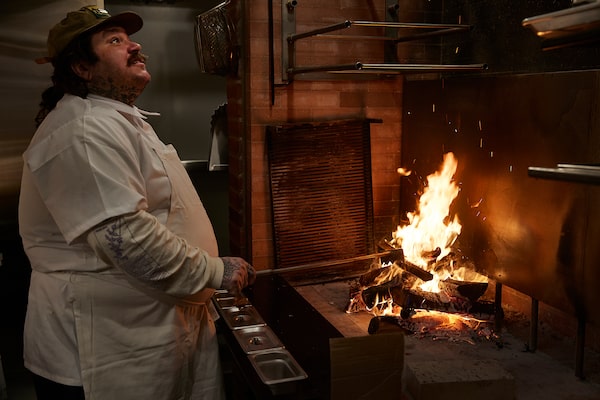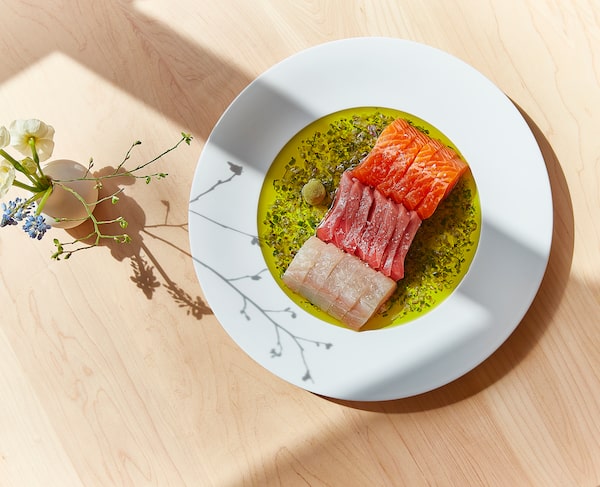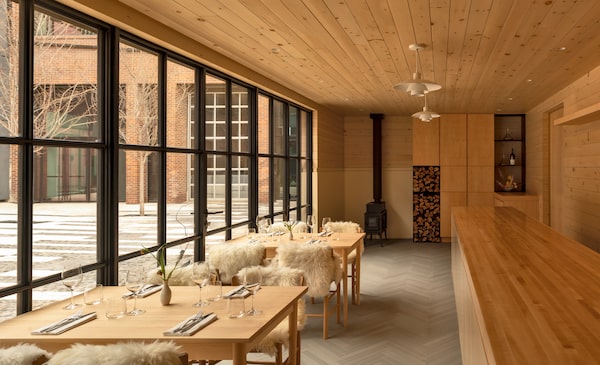
It took engineers six months to figure out how to suspend 9,000 pounds of white maple from the ceiling of Prime Seafood Palaceadrian ozimek/Handout
On a bustling section of Toronto’s Queen St. West sits an unremarkable white-brick building with smoky windows that no one, frankly, would look at twice. It’s a little bit boring. Most definitely bland, and it is exactly the kind of nondescript aesthetic that celebrity chef Matty Matheson was aiming for with the exterior of his most ambitious restaurant to date, Prime Seafood Palace, which opened its doors a month ago.
The reason he wanted the outside to be, well, forgettable is because the interior is anything but. All warm wood, sumptuous leather and soothing brass accents, it was created with one directive: Matheson asked architect Omar Gandhi to “build a wooden cathedral inside a building.” A tall order, but one the affable restaurateur says Gandhi nailed with his first drawing for the 2,700-square-foot space.
Prime Seafood Palace was six years in the making. A lifetime, Matheson adds, but worth the wait. “People have this perception of me,” says Matheson, referring to his party boy persona of a decade ago when he starred in boundary-pushing cooking shows on Viceland. “I wanted a restaurant that said I’m 40 now. I’m more mature. I have kids. I’m not a crazy, wild dude any more. I just want to serve nice steaks and great seafood and vegetables from my garden. This space speaks to that.”
Purposefully, Matheson sought out an architect with no experience designing restaurants. The reason? He didn’t want someone with preconceived notions of how a restaurant should look and feel. He had seen some of the beautiful, contemporary homes Gandhi had done in the Maritimes – where Matheson lived as a young boy and has strong family ties – so he sent the architect a direct message on Instagram. Gandhi, who didn’t have a clue who Matheson was, says he was a little startled to get a DM that said: “Hey, I really love the work you’re doing, would you be interested in doing a restaurant?” They set up a call. They clicked and the rest is history.

Structural issues and the pandemic led to significant delays in the restaurant's completion.adrian ozimek/Handout
“At one point I wanted to have a giant neon sign on the outside of a cow fishing for a tuna but that never happened,” says Matheson. The restaurant took so long to complete, he adds, for many reasons. First, there were structural problems. “We had to rebuild the building,” says Matheson. “Then all of a sudden it was welcome to the pandemic. The thing that is wild is when I started this project I lived in Toronto and I didn’t even have children. Now I have three kids and I live in Fort Erie. It feels like a lifetime ago.”

The long maple bar is reminiscent of a giant butcher's block, while the swivel bar stools are a nod to Matheson’s grandfather, who ran a home-style diner. Approximately 9,000 pounds of maple are suspended from the restaurant's ceiling.doublespace photography/Handout
“Both Matty and I were driven by the feeling of nostalgia, for those places we visited in our lives that seem to grow old along with a city and develop a patina that makes the space richer over time,” explains Gandhi. The bar is like a giant maple butcher block, while the swivel bar stools are a nod to Matheson’s grandfather, who ran a homestyle diner called the Blue Goose in Crapaud, Prince Edward Island. “Sometimes we used to grab our sleeping bags and sleep on the banquettes in the soda shop. When everything closed down we would get up and run around like we owned the place,” he says, comparing the experience to the movie Night at the Museum. “It left an indelible mark on me and my life.”

Matheson, seen here manning the stove at Prime Seafood Palace, curates the restaurant’s playlist. It's all ‘60s and ‘70s rock.Peter Lusztyk/Handout
Gandhi dined at the restaurant for the first time two weeks ago and admits he was “emotional and a little bit nervous.” The butterflies, he adds, went away quickly. “Everyone in the place was excited and I was blown away by the energy, with Led Zeppelin and Grateful Dead playing in the background.” He adds that Matheson curates the restaurant’s playlist, which is all ‘60s and ‘70s rock. “The overriding ambition was that the ambience and the food could not be pretentious. You can’t eat the caviar or the cote de boeuf without making a bit of a mess, so you just have go for it and dig in, just like Matty would.”

Scandinavian, Japanese and Maritime influences dominated architect Omar Ghandi's design.doublespace photography/Handout
There are many influences in this space: Scandinavian, Japanese and Maritime. The dining room and kitchen all flow together, separated by brass screens that function as very soft divisions between the different areas. When Matheson started dreaming about this place, his intention was to have one restaurant for the simple reason that they are so much work. “It’s the only business where you can be the hottest restaurant in the city and still be incredibly in debt.” That plan fell off the rails in the last year and a half and now Matheson is co-owner of five restaurants.

Canara Woodworking of Toronto built these banquettes, which are upholstered in leather from Danish brand Sorenson.adrian ozimek/Handout
The banquettes, made by Canara Woodworking of Toronto, are covered in peachy leather from Denmark’s Sorenson, an eco-friendly, sustainable brand. The wood tables (with hidden drawers for steak knives) and Edwin chairs (a nod to the Maritimes) were made by Coolican & Company, Toronto’s first small-batch design and fabrication studio. Brass lights, which imbue the room with a slow glow, are from Concord. Matheson, who oversaw every detail, even designed his own pepper mills and salt cellars in black lacquered oak from Castor.

Prime Seafood Palace's food, like its design, shows tasteful restraint.Peter Lusztyk/Handout
Like the space itself, the food also shows a lot of restraint. Even the cocktails are garnish-less. “We’re trying to strip everything back to its true form,” says Matheson, whose Blue Goose Farm (as well as many others in and around Toronto) supplies all the produce. Chef Coulson Armstrong (formerly of Canoe) has sourced local food growers, ranchers and farmers and lined up close to 100 purveyors for fruits, vegetables, Ontario beef, lamb, pork and, of course, Atlantic seafood.

This extension of the restaurant, which Matheson calls “the cottage” will seat 12 at tables and another seven at the bar.adrian ozimek/Handout
The main floor of the restaurant flows like the main floor of a house and includes a cozy space Matheson has christened “the cottage.” Soon to open, it will seat 12 at tables and another seven at the bar, with spillover moving outside to the courtyard in nice weather. The walls are knotty pine, the floor a grey herringbone tile, and a small Jotul fireplace, tucked in one end, will warm the space as the weather cools in the fall.
Plan your weekend with our Good Taste newsletter, offering wine advice and reviews, recipes, restaurant news and more. Sign up today.




 Gayle MacDonald
Gayle MacDonald